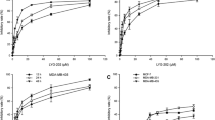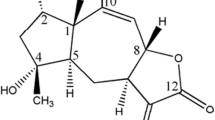Abstract
Medicinal plant extracts have been widely used for cancer treatment. Nitidine chloride (NC) is a natural bioactive alkaloid that has recently been reported to have diverse anticancer properties. We aimed to investigate the cytotoxic effects of NC and the effectiveness of combinatorial treatment including NC and doxorubicin in breast cancer cells. Using MTT and flowcytometry assays, we found that NC induced cell growth inhibition and G2/M cell cycle arrest in a time- and dose-dependent manner both in MCF-7 and MDA-MB-231 breast cancer cell lines. Cancer cell growth inhibition was associated with increased levels of the p53 and p21 proteins. Apoptosis induction by NC treatment was confirmed by JC-1 mitochondrial membrane potential, annexin V-positive cell, and TUNEL staining. Using western blot analysis, we found that NC upregulated the pro-apoptotic proteins Bax, cleaved caspase-9 and -3 and cleaved PARP and that it downregulated the anti-apoptotic proteins Bcl-2 and PARP. By using the PI3K/Akt inhibitor LY294002, we further demonstrated that NC-induced apoptosis might be Akt-specific or dependent. In addition, NC exhibited a synergistic effect with doxorubicin on the growth inhibition of the human breast cancer cell lines MCF-7 and MDA-MB-231. Our study demonstrated the anticancer effect of NC on breast cancer and highlighted the potential clinical application of NC.







Similar content being viewed by others
References
Yedjou C, Izevbigie E, Tchounwou P. Preclinical assessment of Vernonia amygdalina leaf extracts as DNA damaging anti-cancer agent in the management of breast cancer. Int J Environ Res Publ Health. 2008;5:337–41.
Ligresti G, Libra M, Militello L, Clementi S, Donia M, Imbesi R, et al. Breast cancer: molecular basis and therapeutic strategies (review). Mol Med Rep. 2008;1:451–8.
Jemal A, Siegel R, Xu J, Ward E. Cancer statistics, 2010. CA: Cancer J Clin. 2010;60:277–300.
Allinen M, Beroukhim R, Cai L, Brennan C, Lahti-Domenici J, Huang H, et al. Molecular characterization of the tumor microenvironment in breast cancer. Cancer Cell. 2004;6:17–32.
Pu CY, Lan VM, Lan CF, Lang HC. The determinants of traditional Chinese medicine and acupuncture utilization for cancer patients with simultaneous conventional treatment. Eur J Cancer Care. 2008;17:340–9.
Wang Z, Jiang W, Zhang Z, Qian M, Du B. Nitidine chloride inhibits LPS-induced inflammatory cytokines production via MAPK and NF-kappab pathway in raw 264.7 cells. J Ethnopharmacol. 2012;144:145–50.
Bouquet J, Rivaud M, Chevalley S, Deharo E, Jullian V, Valentin A. Biological activities of nitidine, a potential anti-malarial lead compound. Malar J. 2012;11:67.
Del Poeta M, Chen SF, Von Hoff D, Dykstra CC, Wani MC, Manikumar G, et al. Comparison of in vitro activities of camptothecin and nitidine derivatives against fungal and cancer cells. Antimicrob Agents Chemother. 1999;43:2862–8.
Chen J, Wang J, Lin L, He L, Wu Y, Zhang L, et al. Inhibition of stat3 signaling pathway by nitidine chloride suppressed the angiogenesis and growth of human gastric cancer. Mol Cancer Ther. 2012;11:277–87.
Fang Z, Tang Y, Jiao W, Xing Z, Guo Z, Wang W, et al. Nitidine chloride inhibits renal cancer cell metastasis via suppressing akt signaling pathway. Food Chem Toxicol: int J Publ Br Ind Biol Res Assoc. 2013;60:246–51.
Fang Z, Tang Y, Jiao W, Xing Z, Guo Z, Wang W, et al. Nitidine chloride induces apoptosis and inhibits tumor cell proliferation via suppressing erk signaling pathway in renal cancer. Food Chem Toxicol: Int J Publ Br Ind Biol Res Assoc. 2014;66:210–6.
Liao J, Xu T, Zheng JX, Lin JM, Cai QY, Yu DB, et al. Nitidine chloride inhibits hepatocellular carcinoma cell growth in vivo through the suppression of the jak1/stat3 signaling pathway. Int J Mol Med. 2013;32:79–84.
Pan X, Han H, Wang L, Yang L, Li R, Li Z, et al. Nitidine chloride inhibits breast cancer cells migration and invasion by suppressing c-src/fak associated signaling pathway. Cancer Lett. 2011;313:181–91.
Hao JQ, Li Q, Xu SP, Shen YX, Sun GY. Effect of lumiracoxib on proliferation and apoptosis of human nonsmall cell lung cancer cells in vitro. Chin Med J. 2008;121:602–7.
Cossarizza A, Baccarani-Contri M, Kalashnikova G, Franceschi C. A new method for the cytofluorimetric analysis of mitochondrial membrane potential using the j-aggregate forming lipophilic cation 5,5′,6,6′-tetrachloro-1,1′,3,3′-tetraethylbenzimidazolcarbocyanine iodide (JC-1). Biochem Biophys Res Commun. 1993;197:40–5.
Levine AJ, Hu W, Feng Z. The p53 pathway: what questions remain to be explored? Cell Death Differ. 2006;13:1027–36.
Dulic V, Kaufmann WK, Wilson SJ, Tlsty TD, Lees E, Harper JW, et al. P53-dependent inhibition of cyclin-dependent kinase activities in human fibroblasts during radiation-induced g1 arrest. Cell. 1994;76:1013–23.
Anttila MA, Kosma VM, Hongxiu J, Puolakka J, Juhola M, Saarikoski S, et al. P21/waf1 expression as related to p53, cell proliferation and prognosis in epithelial ovarian cancer. Br J Cancer. 1999;79:1870–8.
Hennet T, Bertoni G, Richter C, Peterhans E. Expression of bcl-2 protein enhances the survival of mouse fibrosarcoid cells in tumor necrosis factor-mediated cytotoxicity. Cancer Res. 1993;53:1456–60.
Calandria C, Irurzun A, Barco A, Carrasco L. Individual expression of poliovirus 2apro and 3cpro induces activation of caspase-3 and parp cleavage in hela cells. Virus Res. 2004;104:39–49.
Yap E, Tan WL, Ng I, Ng YK. Combinatorial-approached neuroprotection using pan-caspase inhibitor and poly (adp-ribose) polymerase (parp) inhibitor following experimental stroke in rats; is there additional benefit? Brain Res. 2008;1195:130–8.
Sebolt-Leopold JS, English JM. Mechanisms of drug inhibition of signalling molecules. Nature. 2006;441:457–62.
Noshita N, Lewen A, Sugawara T, Chan PH. Evidence of phosphorylation of akt and neuronal survival after transient focal cerebral ischemia in mice. J Cereb Blood Flow Metab: Off J Int Soc Cereb Blood Flow Metab. 2001;21:1442–50.
Stein R, Smith MR, Chen S, Zalath M, Goldenberg DM. Combining milatuzumab with bortezomib, doxorubicin, or dexamethasone improves responses in multiple myeloma cell lines. Clin Cancer Res: Off J Am Assoc Cancer Res. 2009;15:2808–17.
Dorai T, Aggarwal BB. Role of chemopreventive agents in cancer therapy. Cancer Lett. 2004;215:129–40.
Surh YJ. Cancer chemoprevention with dietary phytochemicals. Nat Rev Cancer. 2003;3:768–80.
Tan AC, Konczak I, Sze DM, Ramzan I. Molecular pathways for cancer chemoprevention by dietary phytochemicals. Nutr Cancer. 2011;63:495–505.
Thomasset SC, Berry DP, Garcea G, Marczylo T, Steward WP, Gescher AJ. Dietary polyphenolic phytochemicals—promising cancer chemopreventive agents in humans? A review of their clinical properties. Int J Cancer J Int Cancer. 2007;120:451–8.
Adams JM, Cory S. The bcl-2 protein family: Arbiters of cell survival. Science. 1998;281:1322–6.
Kim R. Unknotting the roles of bcl-2 and bcl-xl in cell death. Biochem Biophys Res Commun. 2005;333:336–43.
Mayorga M, Bahi N, Ballester M, Comella JX, Sanchis D. Bcl-2 is a key factor for cardiac fibroblast resistance to programmed cell death. J Biol Chem. 2004;279:34882–9.
Precht TA, Phelps RA, Linseman DA, Butts BD, Le SS, Laessig TA, et al. The permeability transition pore triggers bax translocation to mitochondria during neuronal apoptosis. Cell Death Differ. 2005;12:255–65.
Eldering E, Mackus WJ, Derks IA, Evers LM, Beuling E, Teeling P, et al. Apoptosis via the b cell antigen receptor requires bax translocation and involves mitochondrial depolarization, cytochrome c release, and caspase-9 activation. Eur J Immunol. 2004;34:1950–60.
Crompton M. Bax, bid and the permeabilization of the mitochondrial outer membrane in apoptosis. Curr Opin Cell Biol. 2000;12:414–9.
Valentijn AJ, Upton JP, Bates N, Gilmore AP. Bax targeting to mitochondria occurs via both tail anchor-dependent and -independent mechanisms. Cell Death Differ. 2008;15:1243–54.
Chipuk JE, Kuwana T, Bouchier-Hayes L, Droin NM, Newmeyer DD, Schuler M, et al. Direct activation of bax by p53 mediates mitochondrial membrane permeabilization and apoptosis. Science. 2004;303:1010–4.
Murray AW. Recycling the cell cycle: cyclins revisited. Cell. 2004;116:221–34.
Abu Bakar MF, Mohamad M, Rahmat A, Burr SA, Fry JR. Cytotoxicity, cell cycle arrest, and apoptosis in breast cancer cell lines exposed to an extract of the seed kernel of Mangifera pajang (bambangan). Food Chem Toxicol: Int J Publ Br Ind Biol Res Assoc. 2010;48:1688–97.
Hall M, Peters G. Genetic alterations of cyclins, cyclin-dependent kinases, and cdk inhibitors in human cancer. Adv Cancer Res. 1996;68:67–108.
O'Connell MJ, Walworth NC, Carr AM. The g2-phase DNA-damage checkpoint. Trends Cell Biol. 2000;10:296–303.
Gardai SJ, Hildeman DA, Frankel SK, Whitlock BB, Frasch SC, Borregaard N, et al. Phosphorylation of bax ser184 by akt regulates its activity and apoptosis in neutrophils. J Biol Chem. 2004;279:21085–95.
Schulze-Bergkamen H, Brenner D, Krueger A, Suess D, Fas SC, Frey CR, et al. Hepatocyte growth factor induces mcl-1 in primary human hepatocytes and inhibits cd95-mediated apoptosis via akt. Hepatology. 2004;39:645–54.
Khan KH, Blanco-Codesido M, Molife LR. Cancer therapeutics: targeting the apoptotic pathway. Crit Rev Oncol Hematol. 2013;90(3):200–19.
Acknowledgements
This work was supported by the National Natural Science Foundation of China (no. 30772133, no. 81072150, no. 81172529, and no. 81272903) and the Shandong Science and Technology Development Plan (no. 2012GZC22115). Disclosure Statement: None. We thank Cunzhong Yuan and Shi Yan for technical supports with experiments. We also thank Xiangnan Kong and Xiaoyan Li for critical discussing and substantial helps.
Conflicts of interest
None
Author information
Authors and Affiliations
Corresponding author
Rights and permissions
About this article
Cite this article
Sun, M., Zhang, N., Wang, X. et al. Nitidine chloride induces apoptosis, cell cycle arrest, and synergistic cytotoxicity with doxorubicin in breast cancer cells. Tumor Biol. 35, 10201–10212 (2014). https://doi.org/10.1007/s13277-014-2327-9
Received:
Accepted:
Published:
Issue Date:
DOI: https://doi.org/10.1007/s13277-014-2327-9




